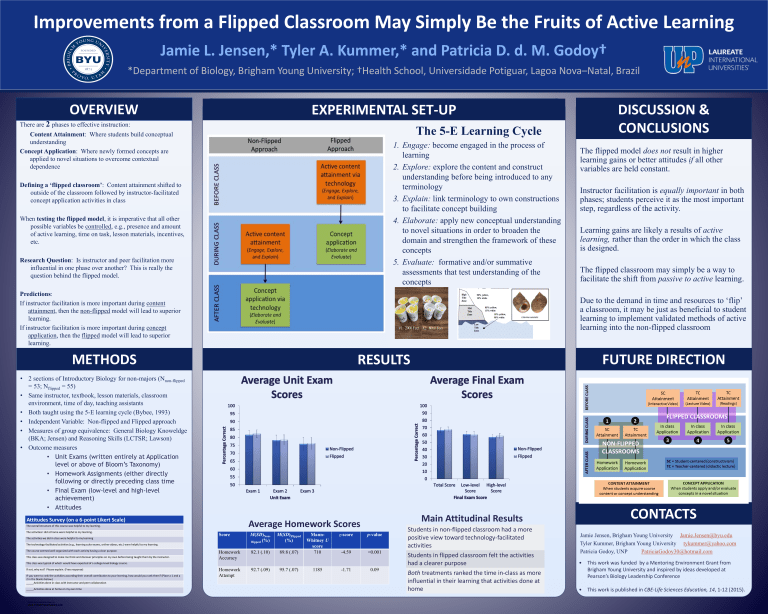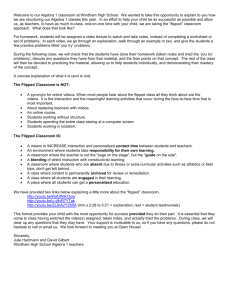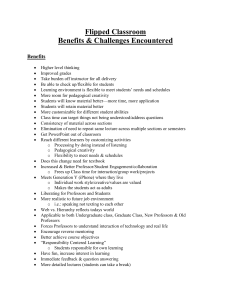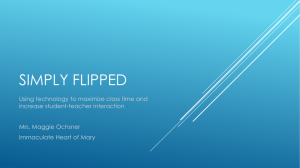Poster Flipped Classroom

Improvements from a Flipped Classroom May Simply Be the Fruits of Active Learning
Jamie L. Jensen,* Tyler A. Kummer,* and Patricia D. d. M. Godoy†
*Department of Biology, Brigham Young University; †Health School, Universidade Potiguar, Lagoa Nova–Natal, Brazil
OVERVIEW
There are 2 phases to effective instruction:
Content Attainment
: Where students build conceptual understanding
Concept Application
: Where newly formed concepts are applied to novel situations to overcome contextual dependence
Defining a ‘flipped classroom’
: Content attainment shifted to outside of the classroom followed by instructor-facilitated concept application activities in class
When
testing the flipped model
, it is imperative that all other possible variables be controlled, e.g., presence and amount of active learning, time on task, lesson materials, incentives, etc.
Research Question
: Is instructor and peer facilitation more influential in one phase over another? This is really the question behind the flipped model.
Predictions
:
If instructor facilitation is more important during content attainment, then the non-flipped model will lead to superior learning.
If instructor facilitation is more important during concept application, then the flipped model will lead to superior learning.
METHODS
•
2 sections of Introductory Biology for non-majors (N non-flipped
= 53; N flipped
= 55)
•
Same instructor, textbook, lesson materials, classroom environment, time of day, teaching assistants
• Both taught using the 5-E learning cycle (Bybee, 1993)
•
Independent Variable: Non-flipped and Flipped approach
•
Measures of group equivalence: General Biology Knoweldge
(BKA; Jensen) and Reasoning Skills (LCTSR; Lawson)
•
Outcome measures
•
Unit Exams (written entirely at Application level or above of Bloom’s Taxonomy)
•
Homework Assignments (either directly following or directly preceding class time
•
Final Exam (low-level and high-level achievement)
•
Attitudes
Attitudes Survey (on a 6-point Likert Scale)
The overall structure of this course was helpful to my learning.
The activities I did at home were helpful to my learning.
The activities we did in class were helpful to my learning
The technology-facilitated activities (e.g., learning suite exams, online videos, etc.) were helpful to my learning.
The course seemed well-organized with each activity having a clear purpose.
This class was designed to make me think and discover principles on my own before being taught them by the instructor.
This class was typical of what I would have expected of a college-level biology course.
If not, why not? Please explain. (Free response)
If you were to rank the activities according their overall contribution to your learning, how would you rank them? (Place a 1 and a
2 in the blanks below.)
_____Activities done in class with instructor and peer collaboration
_____Activities done at home on my own time
RESEARCH POSTER PRESENTATION DESIGN © 2012 www.PosterPresentations.com
EXPERIMENTAL SET-UP
The 5-E Learning Cycle
1. Engage:
become engaged in the process of learning
2. Explore:
explore the content and construct understanding before being introduced to any terminology
3. Explain:
link terminology to own constructions to facilitate concept building
4. Elaborate:
apply new conceptual understanding to novel situations in order to broaden the domain and strengthen the framework of these concepts
5. Evaluate:
formative and/or summative assessments that test understanding of the concepts
DISCUSSION &
CONCLUSIONS
The flipped model
does not
result in higher learning gains or better attitudes
if
all other variables are held constant.
Instructor facilitation is
equally important
in both phases; students perceive it as the most important step, regardless of the activity.
Learning gains are likely a results of
active learning,
rather than the order in which the class is designed.
The flipped classroom may simply be a way to facilitate the shift from
passive to active
learning.
Due to the demand in time and resources to ‘flip’ a classroom, it may be just as beneficial to student learning to implement validated methods of active learning into the non-flipped classroom
RESULTS FUTURE DIRECTION
Score
Homework
Accuracy
Average Homework Scores
M(SD)
Nonflipped
(%)
M(SD)
Flipped
(%)
82.1 (.10) 89.8 (.07)
Mann-
Whitney U score
710
z-score
-4.59
p-value
<0.001
Homework
Attempt
92.7 (.09) 95.7 (.07) 1185 -1.71
0.09
Main Attitudinal Results
Students in non-flipped classroom had a more positive view toward technology-facilitated activities
Students in flipped classroom felt the activities had a clearer purpose
Both treatments ranked the time in-class as more influential in their learning that activities done at home
CONTACTS
Jamie Jensen, Brigham Young University Jamie.Jensen@byu.edu
Tyler Kummer, Brigham Young University tykummer@yahoo.com
Patricia Godoy, UNP PatriciaGodoy30@hotmail.com
• This work was funded by a Mentoring Environment Grant from
Brigham Young University and inspired by ideas developed at
Pearson’s Biology Leadership Conference
• This work is published in CBE-Life Sciences Education, 14, 1-12 (2015).





